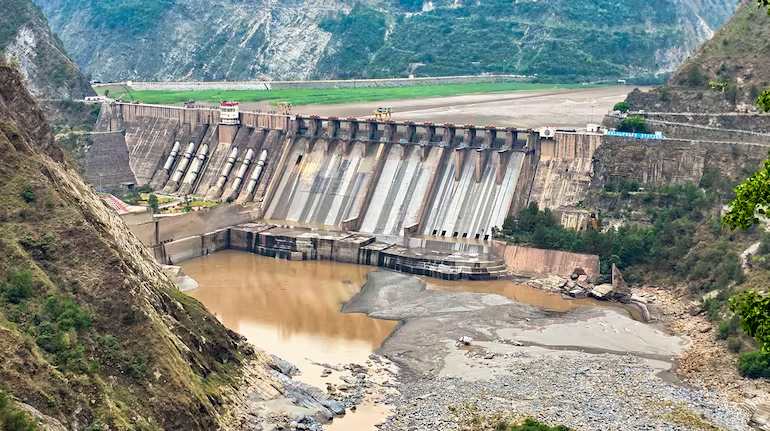Following a deadly terror attack in Jammu & Kashmir, India suspended the Indus Waters Treaty with Pakistan and has now launched its first large-scale dam maintenance push in Kashmir in decades.
BY PC Bureau
In a significant departure from decades of protocol, India has begun an extensive maintenance program for its vital hydroelectric dams in Jammu & Kashmir, a move made possible by the recent suspension of the Indus Waters Treaty (IWT) with Pakistan. For the first time, sediment has been successfully flushed from three major dams on the Chenab River, marking the initial phase of a comprehensive initiative led by the National Hydroelectric Power Corporation (NHPC) Ltd, India’s largest state-owned hydropower company.
The decision to suspend the IWT, which has governed water-sharing between India and Pakistan for over six decades, came in response to a terrorist attack in Pahalgam, Jammu & Kashmir, on April 22, 2025. This suspension has effectively removed long-standing restrictions on how India manages its western rivers under the treaty, paving the way for these critical infrastructure upgrades.
Boosting Power Generation on the Chenab
The initial phase of this ambitious program involved the successful flushing of accumulated sediment from the Salal (690 MW), Baglihar (900 MW), and Dulhasti (390 MW) hydroelectric projects. All three dams are crucial to India’s energy security and are strategically located on the Chenab River. Decades of limited maintenance, often constrained by IWT provisions, had led to sediment buildup, which in turn reduced reservoir capacity and hampered power generation efficiency. This initial flushing is expected to immediately improve the operational output of these facilities.
India is quietly rewriting the rules in Kashmir’s rivers.
For the first time ever, we’ve flushed out massive sediment buildup from two major dams—#Salal and #Baglihar on the #Chenab. This isn’t just maintenance. It’s a game-changer for energy, environment, and strategy. 🇮🇳💧 pic.twitter.com/71nDYMHypM
— Dateline Kashmir (@afrahshah1) July 16, 2025
Building on this success, NHPC has already invited bids for a range of further enhancements, including mechanized desilting, structural repairs, and other comprehensive maintenance activities. These efforts are designed to ensure the long-term health and optimal performance of these critical assets.
A New Era for Dam Management: The Salal Example
A particularly noteworthy development underscores the newfound flexibility India now has. On July 8, 2025, a tender was issued for the first-ever post-monsoon hydrographic survey of the Salal dam reservoir at Dhyangarh for the 2025–26 period. The Salal dam, operational since 1987, has never before undergone such a comprehensive survey. Under the previous IWT framework, sediment flushing was typically limited to just once annually, usually in August, significantly hampering routine and essential maintenance. This restriction meant that critical surveys and proactive desilting efforts, vital for maintaining reservoir health and power generation capacity, were often deferred or conducted with severe limitations.
READ: Centre Backs Governor Bhalla, Snubs Demand for Elected Govt in Manipur
READ: Ladakh’s Power Shift Ignites Hopes and Tensions for Game-Changing Statehood Talks
India had previously sought to renegotiate parts of the IWT, citing evolving hydrological conditions in the Indus river basin and the ever-increasing domestic water demands driven by its burgeoning population. The suspension of the treaty now allows India to advance these operations independently, free from the requirement of prior notification to Pakistan. This autonomy is seen as crucial for India to effectively manage its water resources and maximize the potential of its hydroelectric projects.
The Baglihar dam, commissioned in 2008, has also benefited from the recent flushing operation and is now slated for its first comprehensive desilting, a process that promises to further unlock its generation potential. Tenders for these extensive desilting and related works are anticipated to be finalized by December 2025, indicating a rapid and decisive progression of the maintenance program.
Geopolitical Implications and India’s Resolve
As expected, Pakistan has vehemently protested India’s treaty suspension, accusing its neighbour of “weaponizing water” and calling for an immediate resumption of bilateral talks on the matter. However, India has firmly continued its comprehensive maintenance program unabated, signalling a clear resolve to prioritize its national infrastructure and water management needs.
This assertive stance by India marks a new chapter in its management of the western rivers and its approach to regional water disputes. The successful execution of these maintenance operations, particularly the unprecedented hydrographic survey of the Salal dam, demonstrates India’s commitment to optimizing its hydroelectric assets and ensuring long-term energy security for its population, even in the face of geopolitical tensions. The outcome of these extensive maintenance works will be closely watched, not only for their impact on India’s energy landscape but also for their broader implications on regional water diplomacy.












